
Table of Contents
Introduction
In this test round-up I'd like to show how the 3dfx Banshee compares (/compared) to its direct competitors, which were:
- the nVidia Riva TNT
- the S3 Savage 3D
- the Matrox G200
The test includes driver versions from late 1998 to reflect the performance when these cards were new to the market and drivers from late 1999 to show what the chip manufacturers were able to improve within roughly a year of driver development.
Also the tests were done on a Pentium III (Katmai) system with the CPU clocked to 500 MHz and downclocked to 333 MHz (5x66).
I think these clockspeeds reflect the target systems very well - 333MHz can be seen as the average "higher level" machine, where one of these cards could have lived in at the time of launch.
The fastest CPU at the end of 1998 was the Intel Pentium II 450 MHz, the Pentium III 500 MHz was introduced in early 1999. So a 500MHz Pentium III machine could still be a valid system, respectively it shows what one of these cards would have been able to do in an overclocked high end system at the end of 1998.
All benchmarks were run at 800x600 and 1024x768 resolutions, because I think these are the 2 relevant resolutions for our test line-up. As a little bonus, all cards were overclocked to their stable maximum and ran all benches again, with the 1024x768 resolution and the "1999" driver on the "500 MHz system", to show what was possible and who would have been on top at the end. The Savage 3D is excluded here, as it is not possible to get even 5 MHz more out of the card.
The only thing that is partly not "true" to the timeframe is the patchlevel of the games. This is especially relevant for Unreal, which had an extremely bad performing D3D rendering path upon release.
So - the results might not be as you remember from back in the day. We'll see shortly which card was the (2D/3D) king in 1998.. forget all that you think to know and let the benches speak for themselves!
The Contenders
Matrox Millenium G200
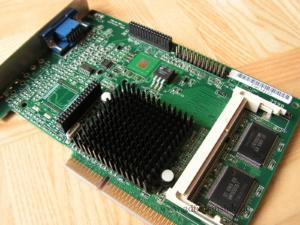
The Matrox G200 chipset was launched in July of 1998 and was the company's first chip fully usable for gaming. It featured excellent signal quality and was also praised for its 3D image quality. Initially, drivers were a little bugged and slow and OpenGL support was missing almost throughout its whole "lifetime" (although a OGL to D3D wrapper was available).
This card has (for the time of its release) extremely fast memory rated for up to 143 MHz and can be upgraded to a total of 16 MB of memory. This card overclocks extremely well. It reaches the highest memory speeds of all cards. I wish I had a memory upgrade module to test it with more VRAM at its disposal.
Sparkle SP391E (S3 Savage 3D)

S3's Savage 3D was a massive leap in performance and was meant to be a budget chip with Voodoo 2-like performance. In reality it was launched with extremely buggy drivers and was plagued by poor manufacturing yields of the modern 250nm manufacturing process. For this reason the Savage 3D mostly is not able to clock higher than the 350nm competition of 1998. With the release of the Riva TNT and the 3dfx Banshee closely ahead its future did not look to bright right from the get-go.
This card also has memory modules rated for 143 MHz, but overclocking it results in artifacts and crashes at only a few Mhz more already ( < 5 ). Same goes for the core. I'm very disappointed of this card in this respect.
Asus V3400TNT (nVidia Riva TNT)
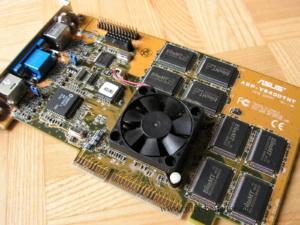
nVidia's TNT is the successor of the relatively succesful Riva128 chip. It was released in September of 1998 and improved on its predecessor in every way. It had excellent 3D image quality (which the Riva128 clearly lacked), featured tons of modern features like full AGP support, 32Bit rendering and Single-Pass-Multitexturing and had good drivers directly upon release. Initially nVidia announced the TNT with significantly higher clockspeeds which the preview cards also ran at. The production cards ran a lot slower (90 MHz compared to the announced 110 MHz) due to the complexity of the chip and the heat it created.
Our review card is additionaly tested at the announced 110 MHz core speed to see what difference it makes. Unfortunately the memory wouldn't run without errors with even a small overclock (although it is rated for 125 MHz).
Asus V3200 (3dfx Banshee)
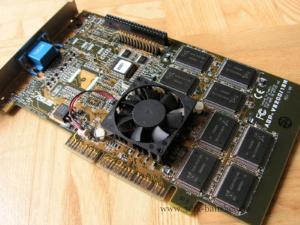
3dfx released the Banshee in October of 1998. It was their first 2D/3D single chip solution and featured the successful Voodoo 2 3D core minus one of its texture mapping units, removing the capability of Single-Pass-Multitexturing but increasing the clockspeed. Because of this, it could reach higher performance in games where Multitexturing was not used, but in games that used multitexturing (like Unreal or Quake II) the Voodoo 2 was much faster. Featurewise it was inferior to the TNT in many ways and it lacked the second TMU, which is a clear disadvantage in more modern games. But it had excellent drivers and game compatibility right from the start.
The Asus V3200 card is definitly one of the finer Banshee cards. It features a really silent fan and top notch signal quality. It also overclocks fairly well - 120 MHz core and memory is possible, but the memory speed of the Gigabyte GA-630 is impossible to reach.
Gigabyte GA-630 (3dfx Banshee)
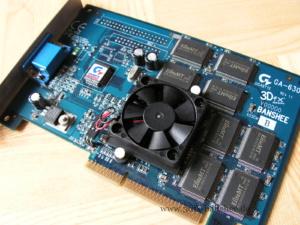
Gigabyte's GA-630 is the fastest Banshee card ever made. It's 130 Mhz memory clock simply makes the difference and cannot be reached by most other Banshee cards. I have some Banshees with 7ns memory (= rated for 143 MHz), but none of these are able to hit the 130 MHz. The GA-630 at stock (110/130) is faster the the Asus V3200 clocked to 120/120 MHz in most games, which tells a lot. It's a great card and also significantly faster than an average Banshee.
The Asus V3200 has better 2D signal quality and a quieter fan, making it the better card overall (when also taking the good OC capabilities into account), but the GA-630 is simply the top performer among all Banshees.
Tech Specs
| Model | Matrox Millennium G200 | Sparkle SP341E | Asus V3400TNT | Asus V3200 | Gigabyte GA-630 |
| Manufacturer | Matrox | S3 | nVidia | 3dfx | 3dfx |
| 3D Chip | G200 (Eclipse) | Savage 3D | Riva TNT (NV4) | Banshee | Banshee |
| Release Date (Chip) | 1998-07 | 1998-08 | 1998-09 | 1998-10 | 1998-10 |
| Manufaturing Process |
350 nm | 250 nm | 350 nm | 350 nm | 350 nm |
| Core Clock | 85 MHz | 100 MHz | 90 MHz | 100 MHz | 110 MHz |
| Mem Clock | 113 MHz | 100 MHz | 110 MHz | 110 MHz | 130 MHz |
| Fill Rate (MPix/s) |
85 | 100 | 180 | 100 | 110 |
| Fill Rate (MTex/s) |
85 | 100 | 180 | 100 | 110 |
| Memory Size / Type |
8 MB SG-RAM | 8 MB SD-RAM | 16 MB SG-RAM | 16 MB SG-RAM | 16 MB SG-RAM |
| Mem Bus Width | 64 Bit | 64 Bit | 128 Bit | 128 Bit | 128 Bit |
| Mem Transfer Rate |
904 MB/s | 800 MB/s | 1760 MB/s | 1760 MB/s | 2080 MB/s |
Drivers Used
| 3D Chip | 3dfx Banshee | nVidia Riva TNT | S3 Savage 3D | Matrox G200 |
| Driver 1998 | v1.01.02 + MiniGL 1.45 | Asus TNT Driver v1.02 | v6.12 | v4.50.0009 + OpenGL ICD beta1 |
| Release Date | 1998-11 + 1998-11 | 1998-12 | 1998-11 | 1998-12 + 1998-12 |
| Driver 1999 | v1.03.04 + MiniGL 1.49 | Detonator 03.53 | v6.13 | v5.41.008 |
| Release Date | 1999-11 + 1999-09 | 1999-10 | 1999-09 | 1999-11 |
Note 1: All cards were benched with the VSync option turned OFF in the drivers. Other than that, all options were kept unchanged. Note 2: The Banshee v1.01.02 driver clocks the memory to 110 MHz, the v.1.03.04 driver clocks the memory to 120 MHz, overwriting the stock speeds. The core speeds remain unchanged. All speeds were manually changed by me to those written to the card's BIOS.
Test System
| CPU | Intel Pentium !!! 500 MHz (5x100) |
| Memory | 128 MB SD-RAM |
| Mainboard | Gigabyte BX2000 (Intel i440BX) |
| Hard Disk | Samsung Spinpoint 80 GB (SP0802N) |
| Software | Windows 98 SE + DirectX 6.1 |
Note 1: For the 333 MHz test, the CPU was downclocked to 5x66 = 333 MHz
Note 2: For the 3dfx Banshee tests with the 1999 driver version, DirectX 7 had to be installed
as otherwise D3D wouldn't work at all
Benchmarks
Descent³
Descent³ was released in June of 1999 and is the newest game in this comparison. It features Direct 3D and Glide in terms of Rendering APIs.
Version: 1.4 | Settings used:

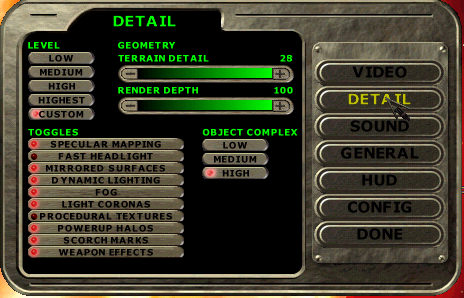
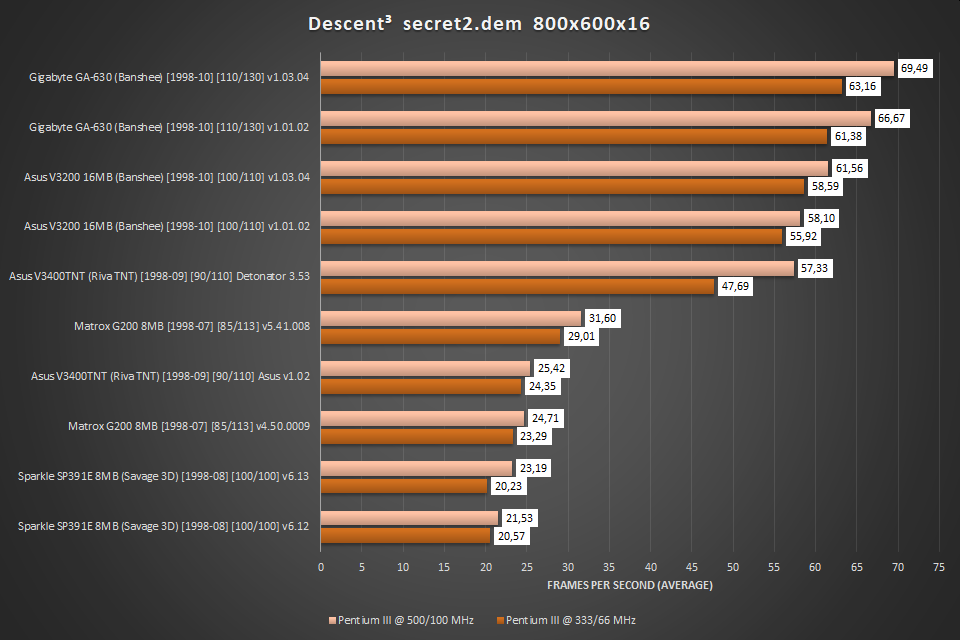
The Banshees ran this benchmark using the Glide API, all other cards were benched using D3D.
The GA-630 is by far the fastest card in this test. Even with the 333 MHz CPU and the older driver from 1998 it matches the speed of the second fastest card, which is the Banshee by Asus with the newer v1.03.04 driver. The TNT with the Detonator 3.53 driver comes close to the Asus Banshee, but this is only true for the CPU running at 500 MHz, at 333 Mhz both Banshees are way faster. Both Matrox G200 and S3 Savage 3D are dramatically slower then TNT and Banshee, regardless of which driver version is used. With the Pentium III clocked to 500 MHz the Gigabyte GA-630 is three times (!!) faster than the fastest result of Sparkle's Savage 3D incarnation. The G200 reaches roughly half the speed of the stock-clocked Banshee of Asus, which is placed third. One notable thing is the performance gain of the TNT with the newer Detonator driver. With the old driver it performes about equal to the G200, with the detonator its performance gets doubled even with the slower 333 MHz CPU already! With the 500 MHz CPU we get to see a massive gain of 125 %. That's some amazing work in the driver department.

The Banshees ran this benchmark using the Glide API, all other cards were benched using D3D. OC results of TNT, Banshee and G200 are also included, but only in the 1024x768 resolution and the newer drivers.
First of all it is clearly visible, that in Descent³ no card benefits from the faster CPU in this resolution. Performance gains are within 1 FPS at best, so even for the fastest cards in this roundup, the 333 MHz CPU is fast enough. Speaking of fast cards - the Gigabyte GA-630 achieves 1st, 2nd and 3rd place using the 1999-ish driver with and without OC, as well as with the 1998 driver respectively. The overclocked TNT @ Detonator 3.53 is placed 4th and is about 10% slower than the GA-630 at stock clocks and driver v1.03.04. The TNT @ Detonator @ stock is placed right between the Asus Banshee results with newer and older driver, respectively. The Banshees and the TNT @ Detonator all deliver well playable framrates of 35+ FPS, the older TNT driver on the other hand performs horribly - only the Savage 3D is slower. The overclocked G200 scores not bad at around 25 FPS but suffers from horrible frametimes. It is clearly visible that the 8MB of RAM are not enough for this resolution.
Expendable
The PC version of Expendable was released in May of 1999 and was a popular benchmark back in the day. It was the first game to feature optional bump mapping effects, that the Matrox G400 series of chips introduced to the market. Expendable is heavily CPU-dependent but it also puts a considerable load to the graphics card with its colorful effects and explosions.
Version: GOG Version (1.0.0.1 ?!) | Settings used:
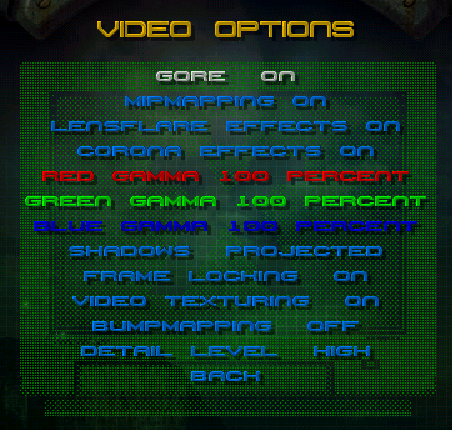
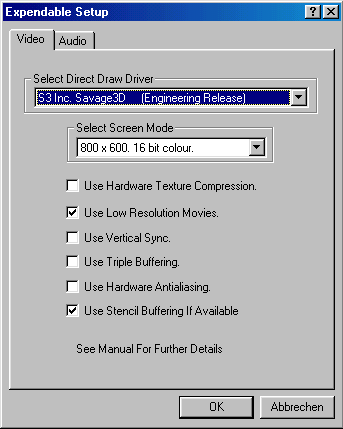
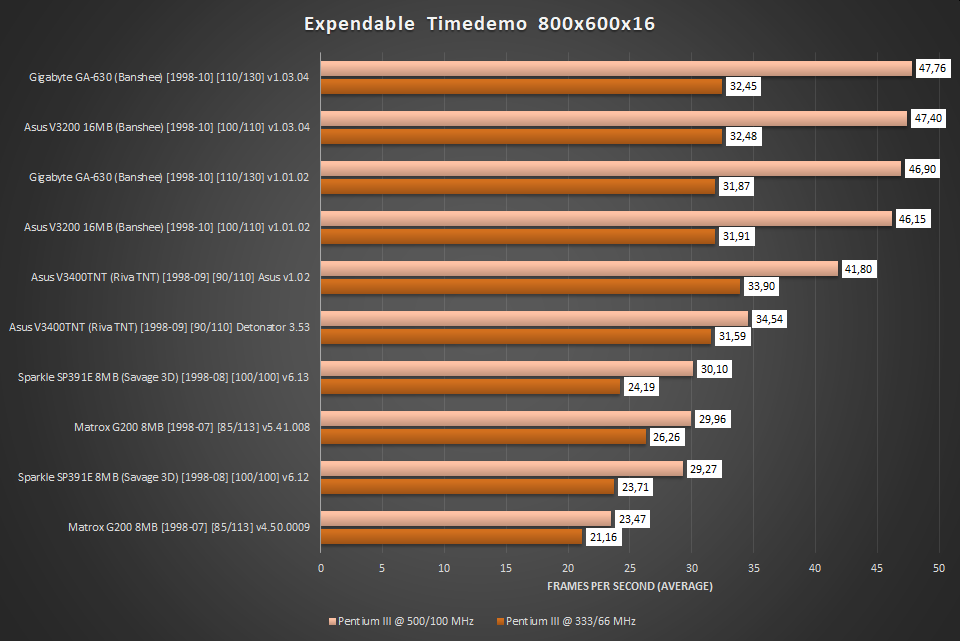
Both Banshees with both driver versions perform relatively identical and are ranked 1st to 4th. They are obviously CPU limited in this resolution, even with the 500 MHz Pentium III. The TNT interestingly performs a lot better with the older driver and ranks 5th, around 10% behind the 4th place. The Detonator driver performs considerably worse, especially with the 500 MHz CPU.
Another really interesting fact is, that the TNT is the overall fastest card with the 1998-ish driver and the 333 MHz CPU. Normally, TNT based cards tend to underperform a bit with slower CPUs.
Savage 3D and Matrox 200 achieve around 30 FPS with the 500 MHz Pentium III, with the exeption of the G200 combined with the older v4.50 driver, which is a lot slower.
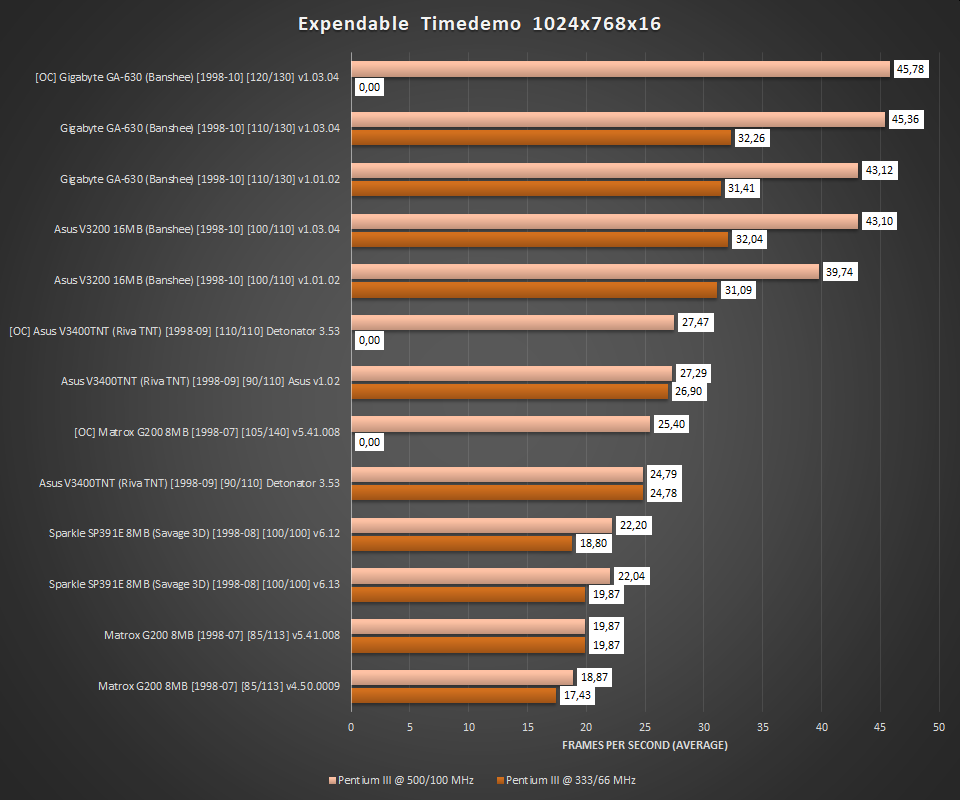
OC results of TNT, Banshee and G200 are also included, but only in the 1024x768 resolution and the newer drivers.
Another triple-victory for the GA-630. Overall the Banshee cards perform worlds better than the Asus TNT, even when overclocked. The slowest Banshee result with the 500 MHz CPU is around 40 FPS, the overclocked TNT achieves 27,5 FPS. Even more interesting is, that all Banshees with all drivers do not lose performance at the 1024x768 resolution compared to 800x600 when the 333 MHz CPU is used. The TNT performs around 20% worse in this resolution, regardless of the driver used. The G200 takes both last places, with both Savage 3D results about 10% faster in front of it. When overclocked, the G200 matches roughly TNT speeds at 25+ FPS, which is a respectable result.
Incoming (Lux et Robur Demo)
The Incoming Demo Version (at that time still additionally named "Lux et Robur") was released in Q1 / 1998.
Compared to the final release it is somewhat less demanding on the hardware, but it scales well with both CPU clockspeed and faster graphics cards, so it is perfect for this roundup. Although, out of all the games tested it is the least demanding.
Version: 1.01 | Settings used:
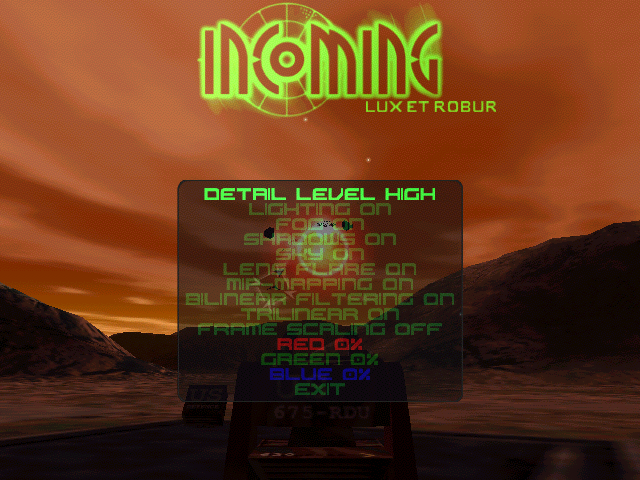

The GA-630 performs best with a solid lead over the second ranked Asus V3200. The TNT @ Detonator gets outperformed by around 50%.
The Matrox G200 massively gains performance and is only 10% slower than the Riva TNT, when the newer drivers are used. With the v4.50 drivers, the G200 is the slowest card in the testfield.
All cards reach almost identical framerates with both CPUs, with the exception of the V3200, which has a pretty bad result with the 333 MHz CPU that I have no explanation for.
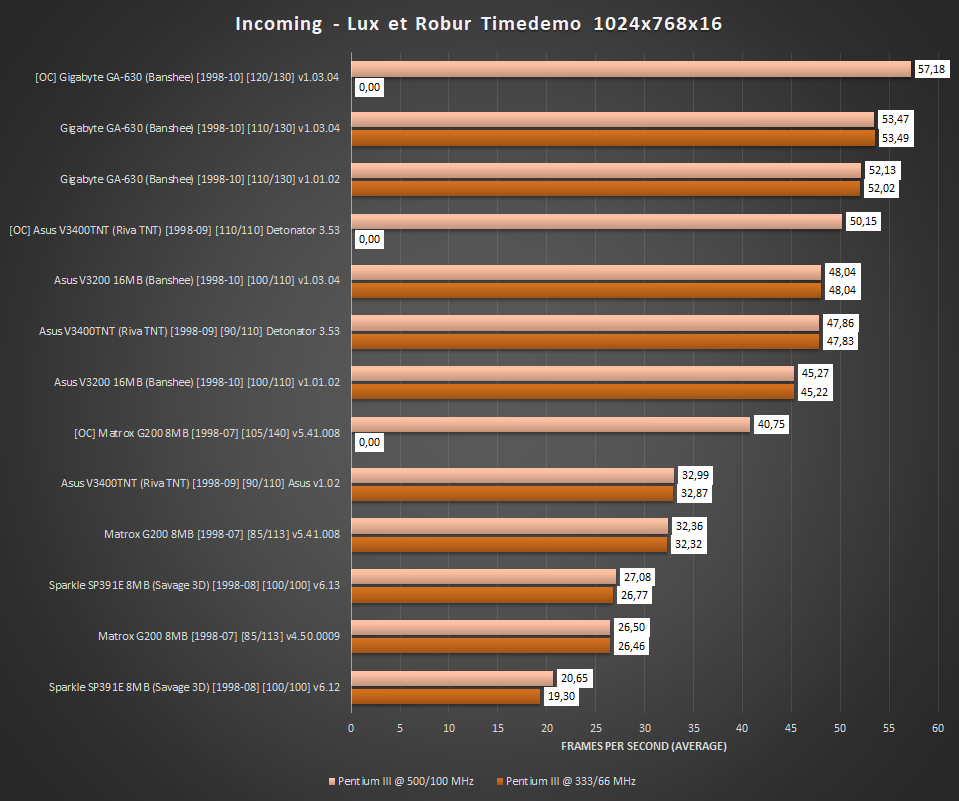
OC results of TNT, Banshee and G200 are also included, but only in the 1024x768 resolution and the newer drivers.
The GA-630 gains another undisputed vitory and scores well above 50 FPS, even at its stock speeds and with the older v1.01.02 driver. The Asus TNT and Banshee cards perform on the same level of 48 FPS with the respective driver versions. The older TNT driver is, again, a whole lot slower. When overclocked, the TNT puts itself right between the 2 Banshees. The OC result of the Matrox is also pretty good - above 40 FPS is well playable. At stock clocks and the more recent driver it performs identically to the TNT with the 1.02 driver at around 33 FPS. The Savage 3D is to slow for 30+ FPS at this resolution. With the 1998-ish driver it is also by far the slowest card in this benchmark. All cards are able to reach their maximum FPS already with the slower 333 MHz CPU.
N.I.C.E. 2 (Breakneck)
N.I.C.E. 2 was released in November of 1998. As it is a racing game, it is ideal to showcase the quality (or the absence of it) of texture filtering. Bad filtering can nicely be revealed on the track. The game itself scales well with both CPU- an GPU- horsepower.
Version: 1.04 | Settings used:
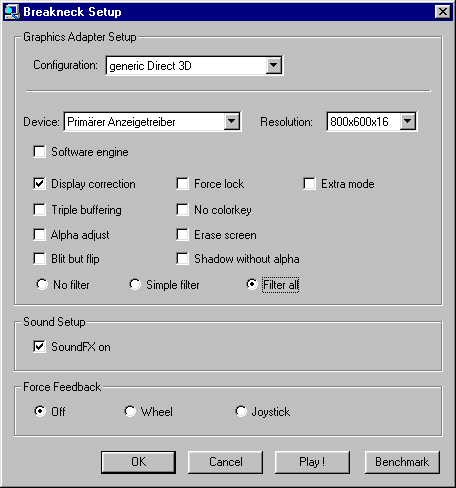
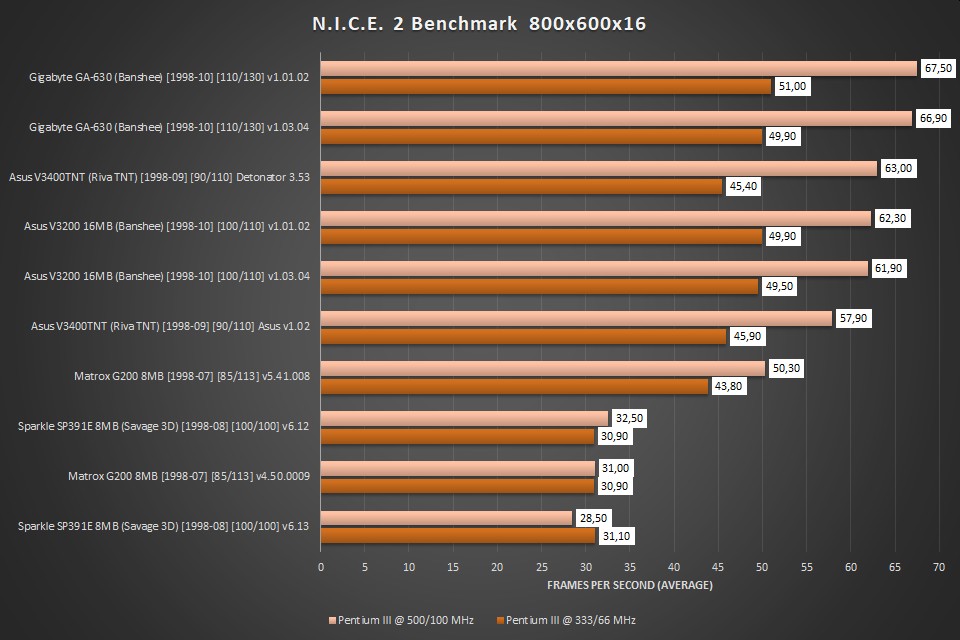
Gigabyte's Banshee ranks 1st and 2nd, with the older driver performing slightly better.
The V3400TNT achieves the 3rd place, only ~4 FPS behind. The Asus Banshee is only a tad slower and comes next.
With the 333 MHz CPU however, the TNT falls back to the performance level of the Matrox G200, which is roughly 10 % behind the 3dfx Banshee based cards.
The performance of the G200 is pretty good overall (over 50 FPS with the Pentium III 500), at least when the v5.41 driver is used. The older driver performs only on the level of the Savage 3D, which is around 30 FPS. Nice work here of the Matrox driver team.

OC results of TNT, Banshee and G200 are also included, but only in the 1024x768 resolution and the newer drivers.
GA-630 and V3400TNT perform about the same in this bench - this stands for stock speeds as well as the OC results, with the GA-630 always maintaning a slim lead of about 1 FPS. Keep in mind, that the Gigabte card is by far the fastest Banshee ever built - the more-standard Asus V3200 is surpassed in all configurations but with the 333 MHz CPU and the old driver. The overclocked Millenium G200 performs at around the level of the Asus Banshee, which is just over 40 FPS. At stock clocks it still scores around 32 FPS with both CPUs, the Savage 3D doesn't get faster than 25 FPS, regardless of CPU and driver used.
Quake 2
The sequel to the extremely popular Quake was released in December of 1997. Quake II was THE benchmark back in the day, often several timedemos of it were used in a single review. The demo1.dm2 timedemo used for this round-up is extremely heavy on the GPU, the also very popular "crusher" timedemo puts more load on the CPU, which is not the focus here.
Version: 3.20 | Settings used:
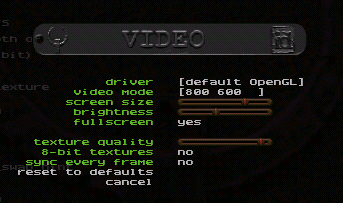
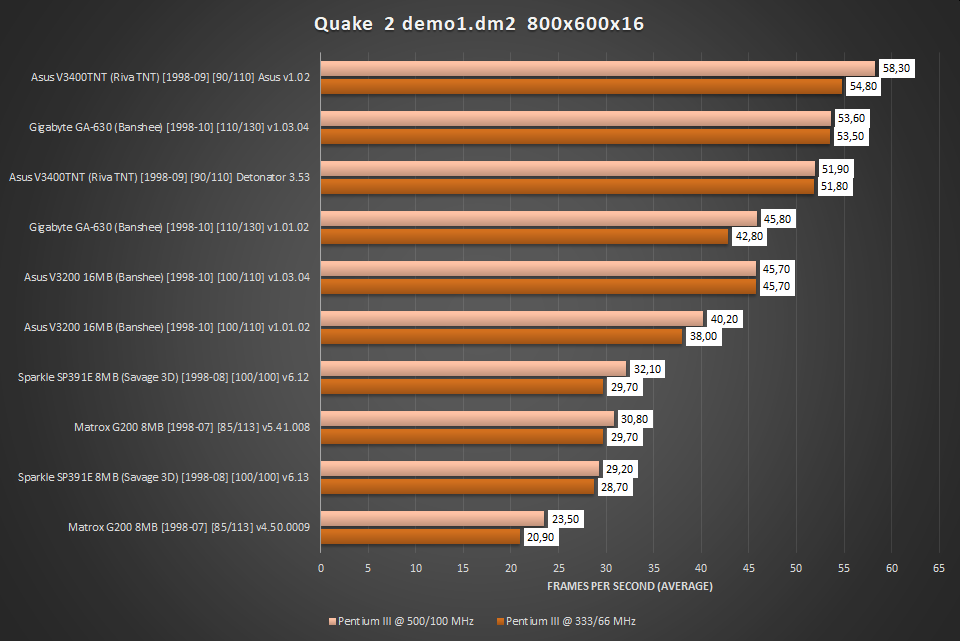
The Banshee cards ran this bench in 3dfx OpenGL, all other cards in default OpenGL.
The TNT wins this bench with the older driver, which is significantly faster than the Detonator 3.53 (which still ranks 3rd). This is strange, since Quake II must have been a game which a driver team at that time must have been heavily focused on. It was one of the most important benchmarks back then and its engine was used in many popular games afterwards.
The Banshees on the other hand gain quite a bit of performance with the newer driver - the V3200 shows a plus of 13,5 %, the GA-630 even 17 % more FPS.
Still, the TNT is clearly dominating this bench. With the 1998 drivers on both TNT and Banshee the Asus V3200 gets outperformed by almost 50% by the TNT card.
The Matrox G200 scores by far the worst with the drivers from 1998, where the then-brandnew beta OpenGL ICD was used. Up to this point in time, G200 owners had to use an OpenGL to D3D wrapper. OpenGL was really no fun with Matrox cards back in the day. The 1999 driver with the full ICD offers performance on the level of Sparkle's Savage 3D, which actually loses a bit of performance with the newer drivers.

The Banshee cards ran this bench in 3dfx OpenGL, all other cards in default OpenGL. OC results of TNT, Banshee and G200 are also included, but only in the 1024x768 resolution and the newer drivers.
The TNT also wins the Quake II benchmark in the higher 1024x768 resolution, leading a solid 10 % before the GA-630 @ v1.03.04 driver and TNT @ Detonator at stock clocks. It is even a bit faster then the OC results of the aforementioned card / driver combinations.
The Asus V3200 with the 1999-ish driver follows behind that duo with around 15% lower FPS, missing the 30 FPS mark.
Both Banshees couldn't run the bench at 1024x768 resolution with the older driver. When this resolution was selected, Q2 always reverted to 640x480 after confirming the change. I'm shure it was possible for Banshee owners to run Quake II at 1024x768 in 1998 (as old benches suggest that..), but with the final Quake II patchlevel of 3.20 and the v1.01.02 driver + all MiniGL drivers released until the end of 1998 I was not able to get it running.
Matrox G200 and Savage 3D are too slow for this resolution, even when overclocked.
Turok 2
Turok 2 - Seeds of evil was released in December of 1998 on the Nintendo 64 and a month later as a PC port. It supports D3D as well as the 3dfx Glide API. The 1998 driver for the 3dfx Banshee does not work with Glide, though. This is also mentioned in the Turok 2 release notes. So the Banshees were tested using D3D with the older drivers and the Glide API was used with the drivers from 1999.
Version: 1.04 | Settings used:
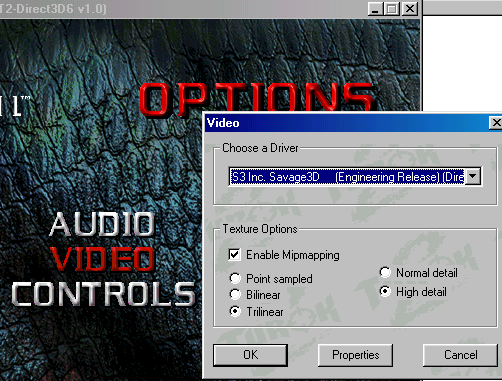
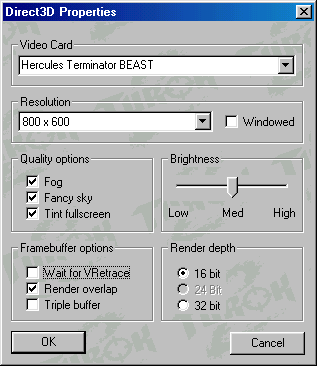
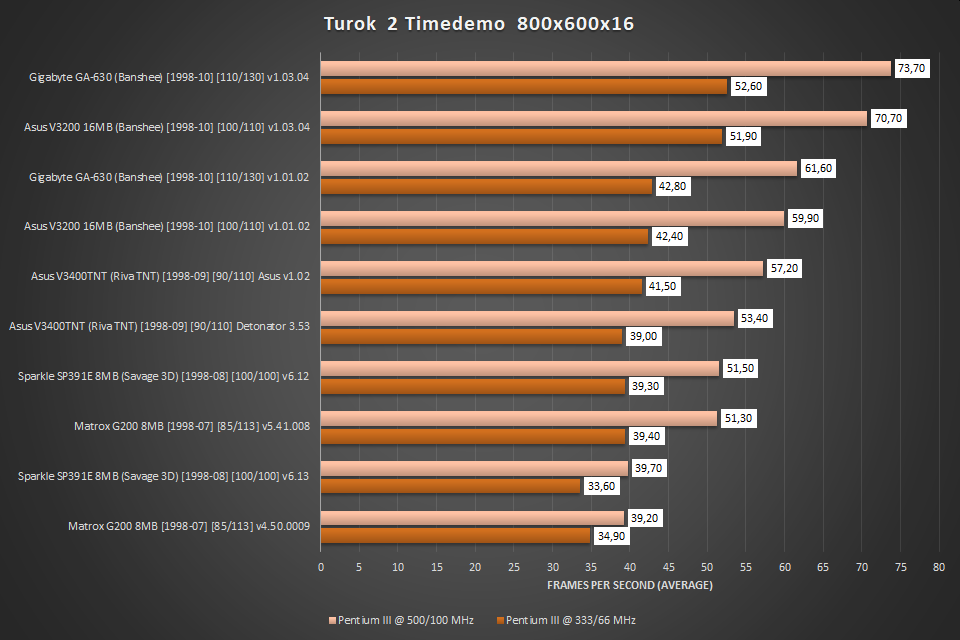
The Banshee cards were benched in Glide with the newer v1.03.04 driver. In the older v1.01.02 driver only D3D is possible with the Banshees. All other cards were also benched using D3D.
The Banshees are by far the fastest cards in this benchmark with the newer driver running under the Glide API. The GA-630 scores almost 30% faster than the best TNT result with the 500 MHz CPU. But also with the older driver and Direct 3D both Banshees are faster than the TNT with both driver versions.
The Savage 3D sensationally performs equal to the G200 @ v5.41 and to the TNT @ Detonator when using the v6.12 driver from 1998. Unfortunately, there is a quite disturbing flickering all over the screen which makes it hard to play the game. The newer v6.13 driver fixes the problem but has a whopping 20 % penalty on the average framerate.
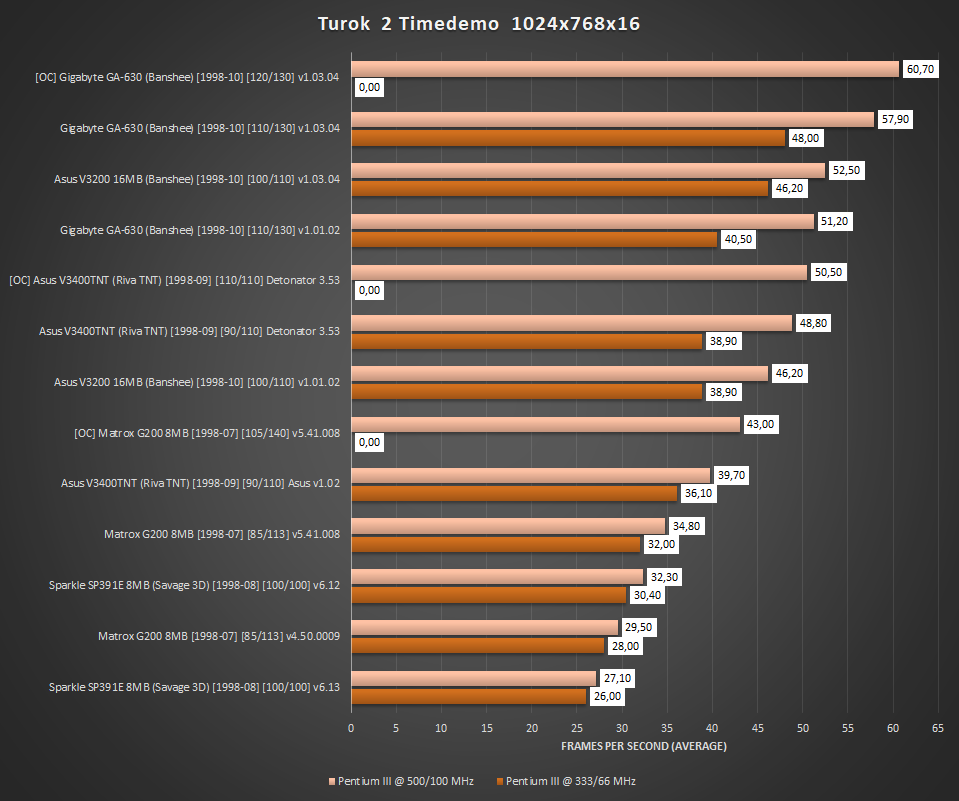
The Banshee cards were benched in Glide with the newer v1.03.04 driver. In the older v1.01.02 driver only D3D is possible with the Banshees. All other cards were also benched using D3D. OC results of TNT, Banshee and G200 are also included, but only in the 1024x768 resolution and the newer drivers.
The Gigabyte Banshee ranks 1st and 2nd again, with the OC result only being a little bit faster than the regular result with the v1.03.04 driver. The Asus V3200 ranks 3rd with the same driver, about 10 % behind.
The V3400TNT @ Detonator ranks 6th, marking the fastest regular TNT result. The OCed TNT is a tiny bit faster and ranks 5th.
The overclocked Millenium G200 achieves a good 43 FPS, which is an almost 25% improvement over the regular result with the same driver.
Sparkle's Savage 3D card scores just over 30 FPS with the flickering 1998-ish driver and just under 30 FPS with the newer driver.
Unreal
The mighty Unreal was the Crysis of the nineties. Released in May of 1998, it was THE game to showcase the power of the than-new 3dfx Voodoo 2 (SLI) cards. Unreal made use of Multitexturing, was the first game to include Detail Textures, featured huge levels, a lot of effects and brought every system to its knees. Furthermore, upon release no API other than 3dfx Glide was even usable. OpenGL was supported but slow, D3D was patched into the game shortly after release but was slow and buggy for a long time. We use one of the latest patches, were every API works without problems.
Version: 2.25f | Settings used:

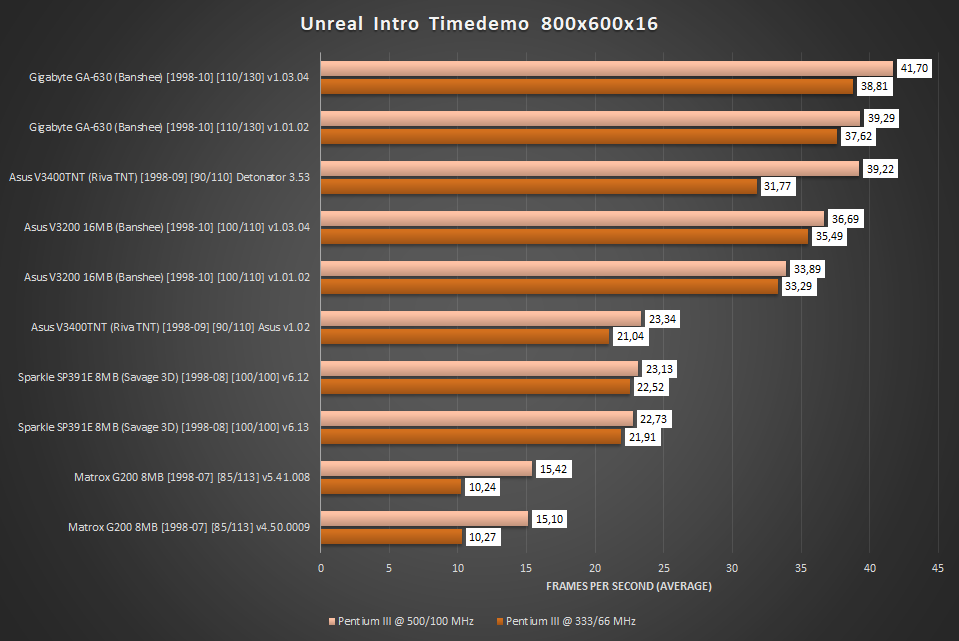
The Banshees were benched under Glide, the Savage 3D under S3 MeTal, Matrox G200 and Riva TNT under Direct 3D.
The GA-630 wins this bench with a tiny lead over the Asus V3400TNT @ Detonator with the 500 MHz CPU. With the Pentium III @ 333 MHz, both Banshees are faster than the TNT.
The Savage 3D scores a respectable 23 FPS with its close-to-the-metal MeTal API, but clearly suffers from its small 8MB Framebuffer, which is already to small for Unreal at the high detail setting. This is even more true for the Matrox G200 which does not have a low-level API at its disposal and is substantially slower than all competitors.
I also want to point out the massive performance gain of the Riva TNT with the newer Detonator driver - at 333 MHz the improvement is already close to 50 %, with the 500 MHz CPU the Detonator even boosts the TNT performance by 68 %! That's like next-gen performance, or in this benchmark, like swapping a Savage 3D out against a TNT or Banshee card.
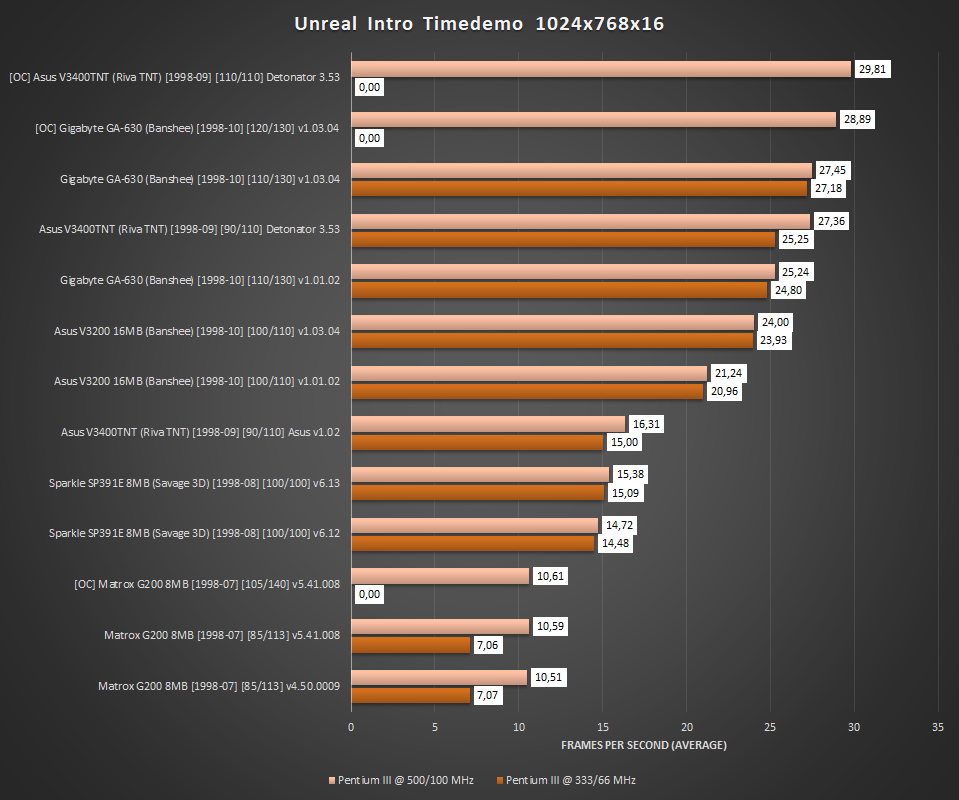
The Banshees were benched under Glide, the Savage 3D under S3 MeTal, Matrox G200 and Riva TNT under Direct 3D. OC results of TNT, Banshee and G200 are also included, but only in the 1024x768 resolution and the newer drivers.
Gigabyte's Banshee and the V3400TNT perform about the same at the stock clocks, with a little advantage for the Banshee when using the slower 333 MHz CPU. The V3200 is a good bit slower, which is even more true with the older v1.01.02 driver - 21 FPS are just not enough. The performance of the whole testfield in general is a bit too low for this resolution, as not even the overclocked cards surpass the 30 FPS mark.
The older TNT driver is again about 40 % slower than the Detonator and performs at about 16 FPS on the level of the Savage 3D. The Millenium G200 scores about 10,5 FPS with both drivers and even with a substantial overclock - the VRAM shortage really shows.
In 1998, the only way to run Unreal with acceptable speed in the 1024x768 resolution was with 2 Voodoo2 cards in SLI.
Scaling with CPU Power
.. at 800 x 600 Resolution
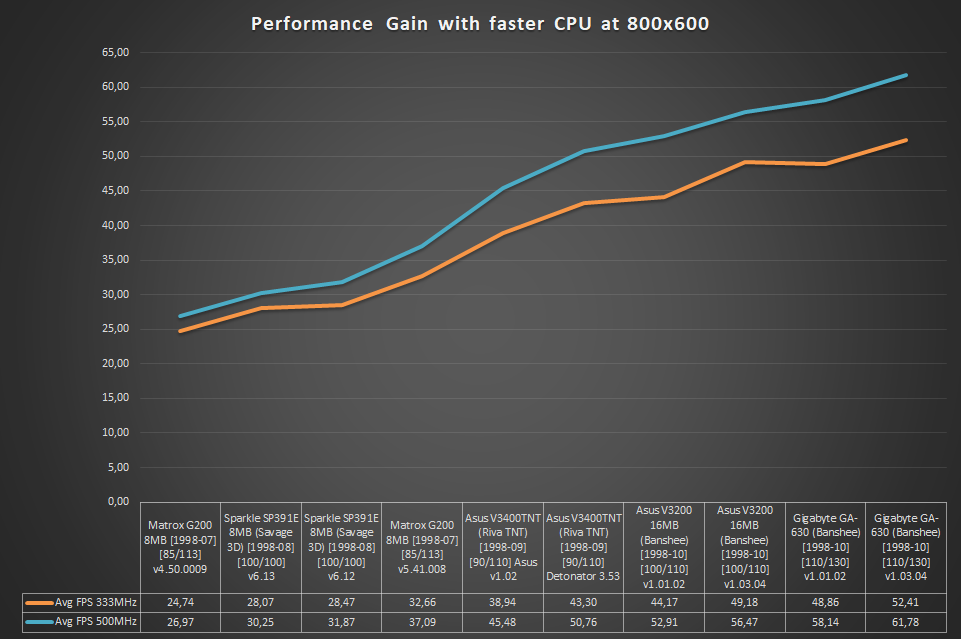
It is clearly visible that the Savage 3D and G200 chips can't make much use of a faster CPU as they show very little scaling, even at this low resolution.
The Asus Banshee scales a lot better with the older drivers, the Gigabyte board shows huge scaling with both driver versions. This tells us 2 things:
- 3dfx optimized their drivers to make better use of CPU resources with newer versions
- The Gigabyte card is able to scale with faster CPUs than the Asus V3200 does
The TNT also scales pretty good (with the Detonator showing a little more improvement), but 3dfx has clearly put a little more effort into optimizing the drivers for slower systems.
.. at 1024 x 768 Resolution
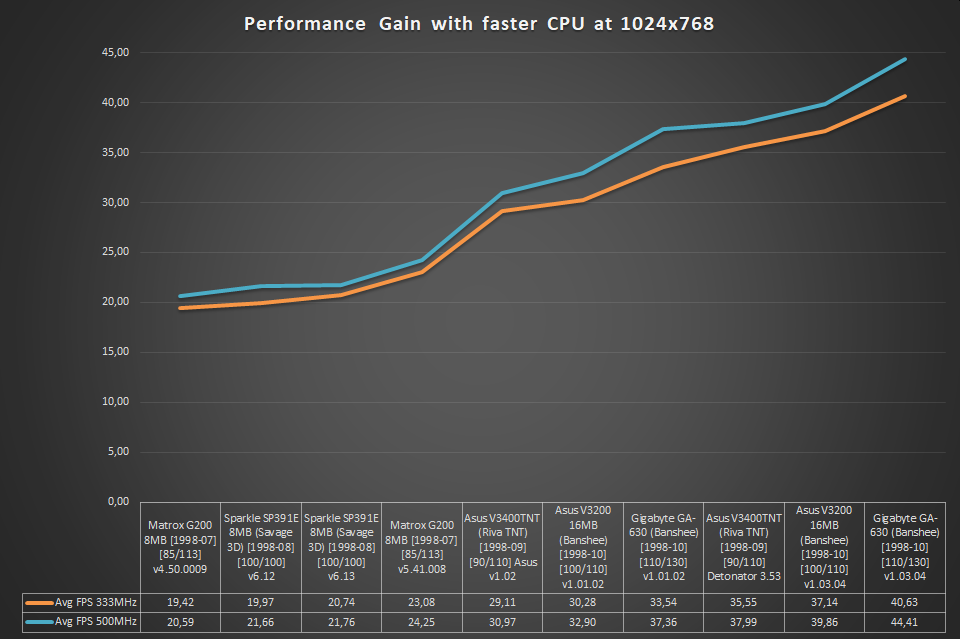
Savage 3D and Matrox G200 show very little scaling with more CPU clockspeed, regardless of the driver versions used, this is also true for the TNT with the older v1.02 driver.
The GA-630 scales best with both drivers showing about 10% scaling.
The Asus V3200 and TNT @ Detonator scale a little less but also a lot better than the S3 and Matrox chips.
Scaling with newer Drivers
.. with Pentium III @ 333/66 MHz
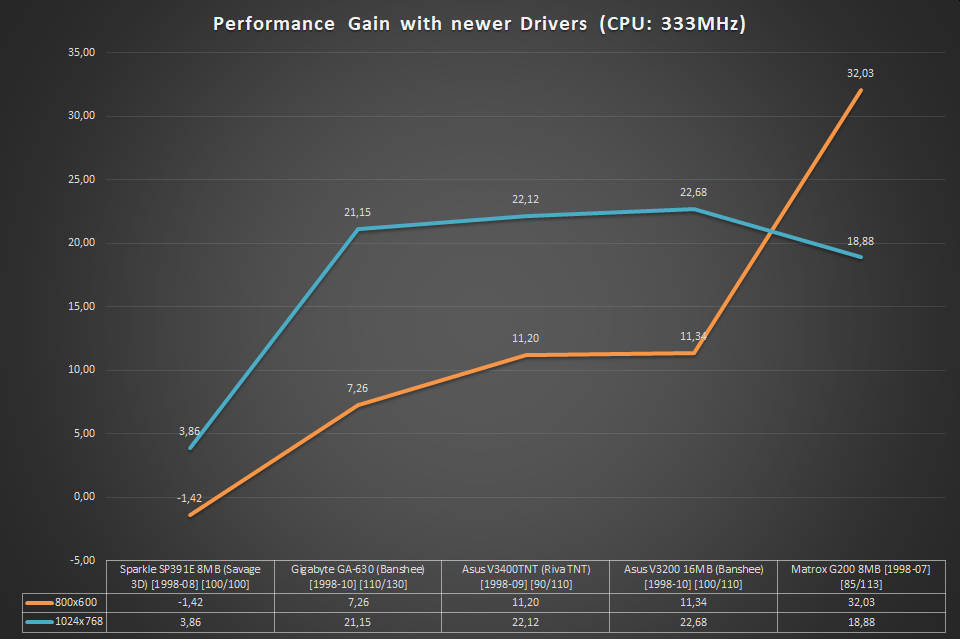
First of all the obvious part of this graph - the Matrox drivers from 1998 were really bad and improved massively within the timeframe of one year. This is especially true for the 800x600 resolution, were the VRAM disadvantage against nVidia and 3dfx is not important. The G200 experiences a phenomenal gain of 32 % performance with the newer driver at 800x600, but only a 19 % increase in the 1024x768 resolution, were all nVidia and 3dfx cards show improvements from ~21 to ~23 % in FPS.
The Savage 3D card actually loses a bit performance in the 800x600 resolution and only gains 4 % in the higher resolution.
.. with Pentium III @ 500/100 MHz
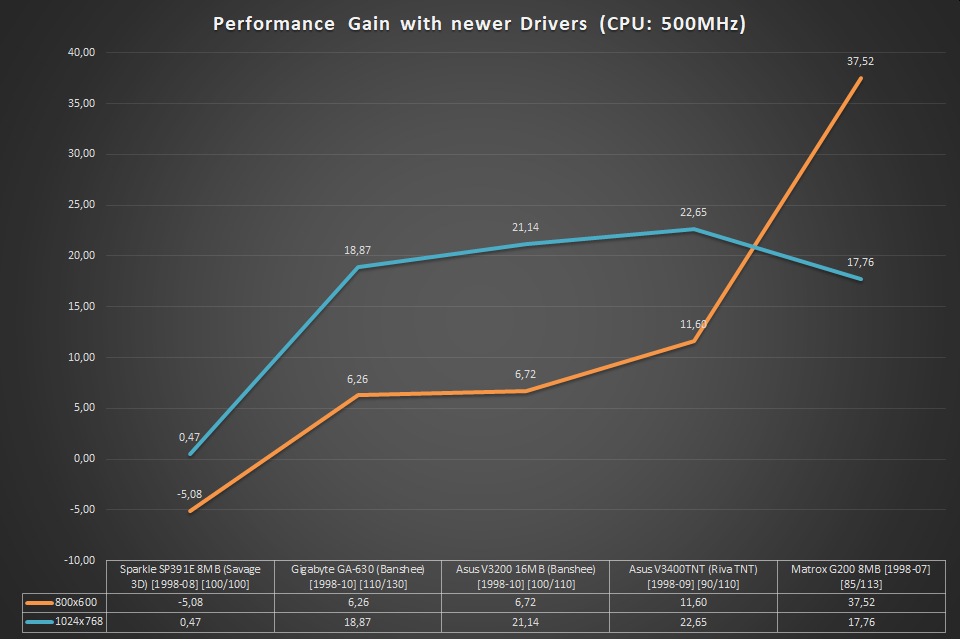
The picture with the 500 MHz CPU is pretty comparable with a few interesting differences.
First of all the Savage 3D shows virtually no improvement at the 1024x768 resolution and loses a significant 5 % performance in the lower resolution. Apart from the performance side of things, the newer S3 drivers offer better game compatibility and remove rendering errors - but S3 did not manage to improve performance at the same time. The chip clearly fell back against its competitors over time.
The TNT pretty much shows the same scaling in percentage as with the 333 MHz CPU, which shows that it is extremely CPU dependent.
The Matrox card even scales a bit better at 800x600 with the faster CPU which shows what a great job the driver team did. An improvement close to 40 % is nothing short of amazing. In 1024x768 the scaling decreases a little - the 8 MB of memory are once more the bottleneck.
At 800x600, both Banshees only scale around 6-7 % with the faster CPU, which is clearly less as with the slower CPU. At the higher resolution, the scaling is roughly comparable to that with the slower CPU.
Overall Performance Ranking
.. at 800 x 600 Resolution
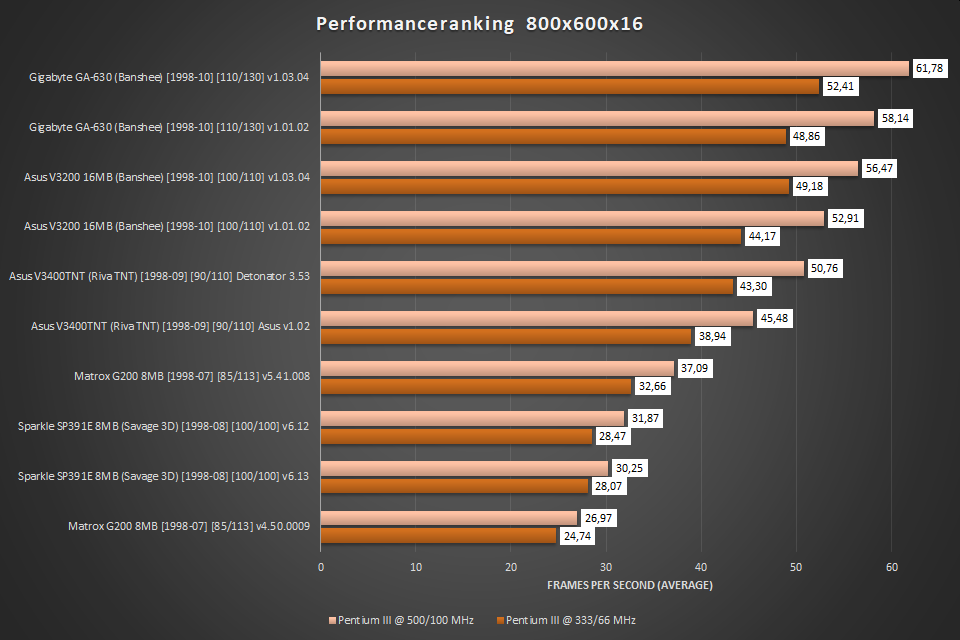
The Banshees rank 1 to 4 in this resolution. The Asus V3200 with the newer driver comes close to the Gigabyte GA-630 using the older driver (even surpassing it slightly with the 333 MHz CPU), which shows the good work in the 3dfx driver department. With both cards using the v1.03.04 driver, the Gigabyte card is around 10 % faster due to its higher clock speeds.
nVidia's TNT has a bit of a hard time at the lower resolution, scoring about 10 % less than the Asus Banshee with both cards using the 1999 driver and the faster CPU.
The Savage 3D shows slightly better performance with the older driver, but is relatively slow overall, running around the 30 FPS mark on average, even at the lower 800x600 resolution.
The Millenium G200 usng the old drivers is a good bit slower than the Savage 3D, but with the newer drivers it is a lot faster than the S3 chip. The G200 with the newer drivers and the 333 MHz CPU is faster than the Savage 3D with its best result using the 500 MHz CPU. With the older driver the exact opposite is the case.
.. at 1024 x 768 Resolution
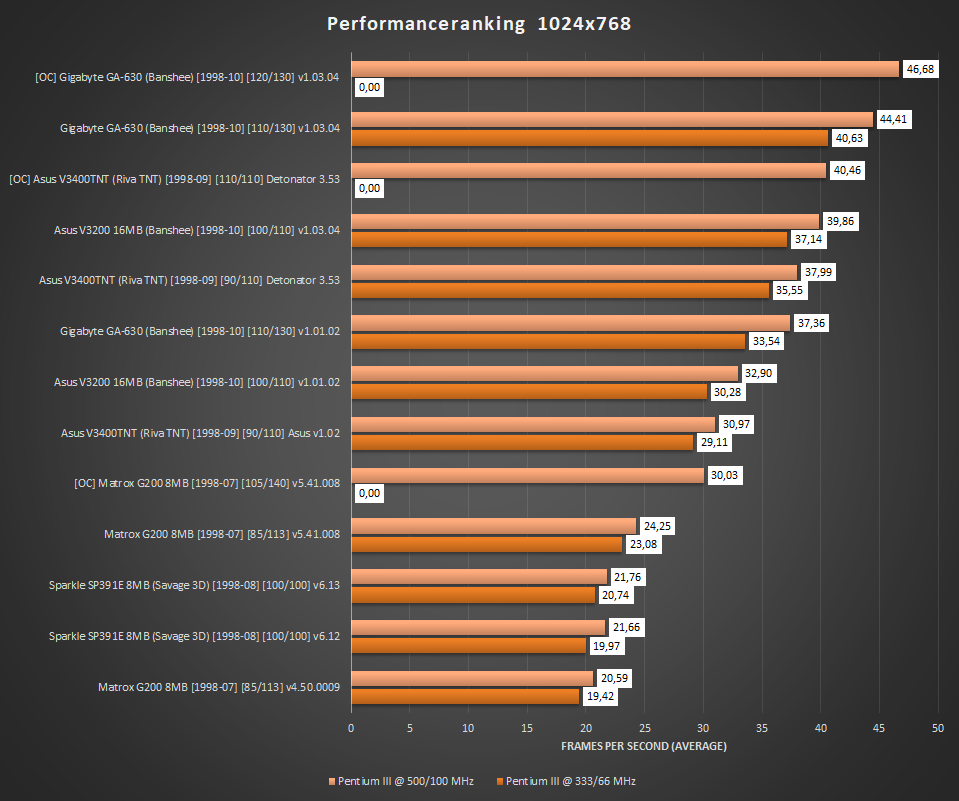
The Gigabyte GA-630 also wins this one with a 10 % lead over the V3200, both using the newer driver. The TNT @ Detonator is a little bit slower than the V3200 - so an average Banshee comes out with a slim lead over a standard TNT. The overclocked TNT @ Detonator is a tiny bit faster than the V3200 @ 500 MHz CPU and the same speed as the GA-630 @ 333 MHz CPU.
The overclocked GA-630 is the undisputed winner of the bench, altough the difference to the regularly clocked GA-630 is not that striking with around 5 % more FPS on average.
TNT and Banshee with older drivers come next in the same order but lower performance.
The overclocked Matrox G200 shows a wonderful scaling of 23,8 % at a chip-clock increase of 23,5 %. With the 500 MHz CPU, it almost matches the TNT speed with it using the pre-Detonator driver. I am really curious what this card could do with 16 MB of RAM and these high clocks.
But I also read that G200 cards with an memory upgrade module installed overclock really poor. Without overclock however, the G200 is too slow for this resolution with ~ 24 FPS on average.
The G200 with the 1998-ish driver as well as the Savage 3D (regardless of driver used) perform even worse, scoring around 21-22 FPS on average.
Special Consideration
Performance Ranking in 1998

Near the end of 1998, the Voodoo Banshee is the fastest single-chip-solution available. Both Banshees win over the Riva TNT. In the higher 1024x768 resolution, the factory-overclocked GA-630 is 20 % in front of the TNT, but the more comparable stock-clocked V3200 is also still around 6% faster than the nVidia offering on average.
In 800x600 both Banshees are clearly faster than the V3400TNT, even the Asus Banshee has a substantial lead over the nVidia card.
On the other end of the chart, the Savage 3D is clearly faster as the G200 in the 800x600 resolution, reaching at least over 30 FPS.
In the higher resolution, both cards are too slow, scoring around 21-22 FPS.
Performance Ranking in 1999
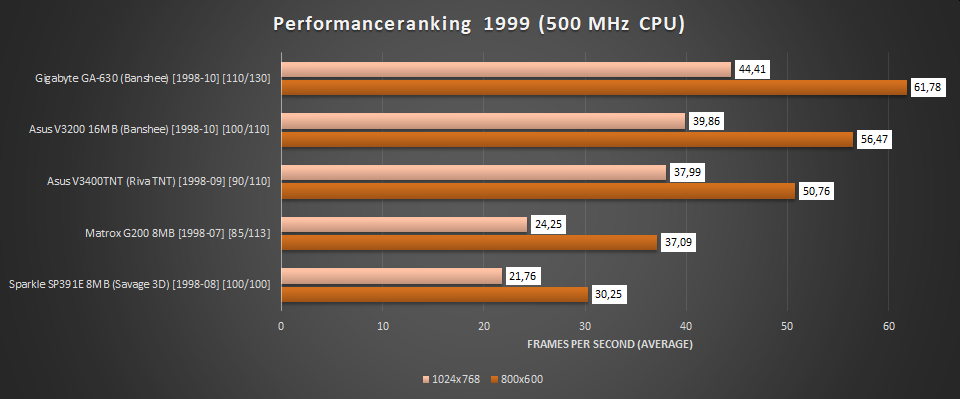
First things first - all cards except of the Savage 3D are able to deliver better performance. The G200 at 800x600 almost matches the speed of a Riva TNT at 1024x768, running at a good 37 FPS. But 1024x768 is still to much for the Matrox card.
The Asus V3400TNT shows a massive improvement of around 23 % at the 1024x768 resolution and comes closer to the V3200, which is still around 2 FPS or 5 % faster. Both cards deliver around 40 FPS at this resolution, which fast enough and a lot faster than the 1998-ish drivers in the first place.
The fastest card overall is again the GA-630, delivering 44,41 FPS at 1024x768 and a whopping 61,78 FPS on average in the 800x600 resolution.
S3's chip is around the same speed at 1024x768 and even loses performance in the lower resolution. It is now clearly the slowest card of the five.
A word on the Rendering Quality
First of all, this is not a comparison of the overall image quality produced. As covered in the past in many (online) reviews and comparisons - in 16 Bit, Matrox delivers the most visually pleasing image quality due to its internal 32 Bit rendering, which is dithered down to 16 Bit. Banshee comes second with 24 Bit internal precision, still preducing a finer 16 Bit image than TNT and Savage 3D.
Banshee had the advantage of an "inexpensively usable" 22 Bit Postfilter, TNT had support for larger textures (1024x1024 as opposed to 256x256 of Banshee and G200), but very few games at that time made use of larger textures. Those who did (like Quake III Arena), showed significantly sharper textures on a TNT rendered image.
Featurewise, the Savage 3D was also excellent - on paper. It had support for textures with a size of up to 2048x2048, the brandnew S3TC texture compression to reduce the performance drop when using the aforementioned texture sizes and - single-pass trilinear filtering, which at least the TNT did not offer.
Practically, S3 ruined this card with its drivers - out of all the tested cards, the Savage 3D showed the most rendering issues. And this is what this part of the article is about - the rendering "experience" using the various cards.
In Descent³, all cards other than the Savage 3D showed flawless rendering with both drivers. The S3 chip showed problems with both driver versions, with a little variation.
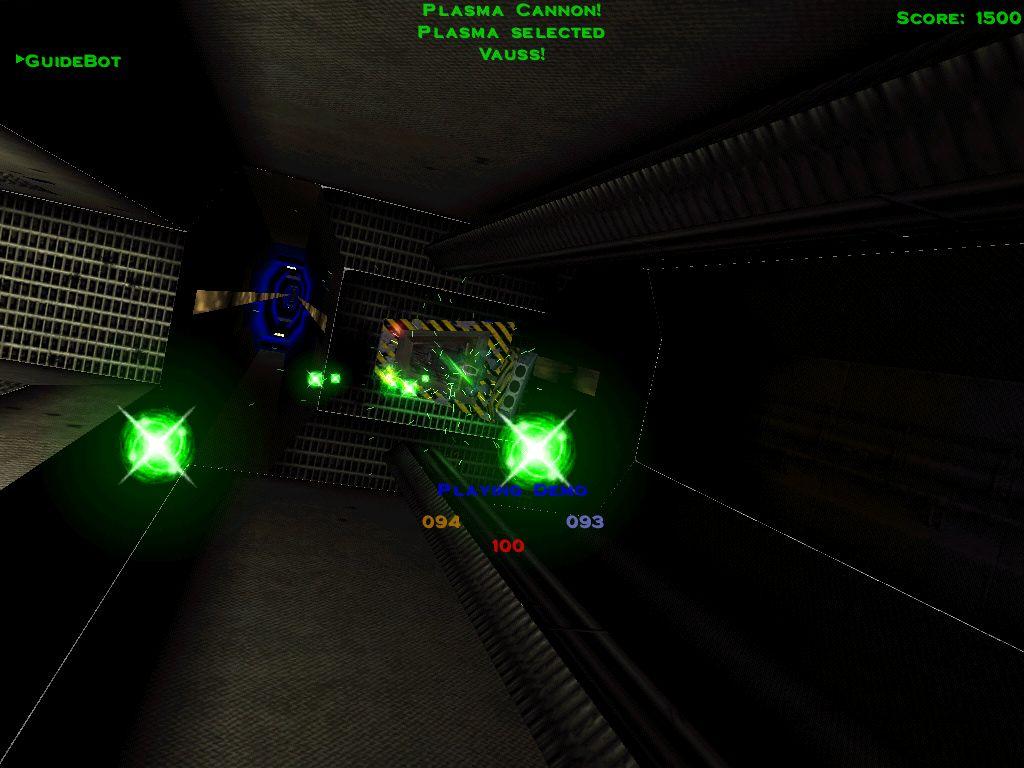
Descent³ on Savage 3D /w v6.12 driver - lots of issues

D³ on Savage 3D /w v6.13 driver - issues persist, colors change

Incoming on Savage 3D /w v6.12 driver - helicopter's rotor missing
With the older driver, shimmering edges / polygon gaps are visible and some lighting looks dark blue. With the newer driver the exact same thing happens, but the light is more a light blue.
Expendable was no problem, all cards produced a decent image. The Savage however showed a heavy flickering all over the screen with the older driver. This can be avoided when VSync is activated. But then, of course, performance is (further) reduced.
Incoming also looked good on all cards and drivers. The only issue was the missing rotor of the helicopter with the Savage 3D combined with the 1998-ish driver. This was a "popular" issue with lots of earlier generation cards and drivers and got sorted out in the newer Savage 3D driver.
With the driver from 1998, TNT and Savage 3D showed very ugly texture filtering in N.I.C.E. 2, which is clearly visible on the racing track. nVidia removed the issue with their Detonator driver, S3 users experienced the same issue in 1999 still. Also, the sun and the lens-flare effects are rendered incorrectly by the Savage 3D using both drivers.

Savage 3D vs. N.I.C.E.2 - faulty sun rendering
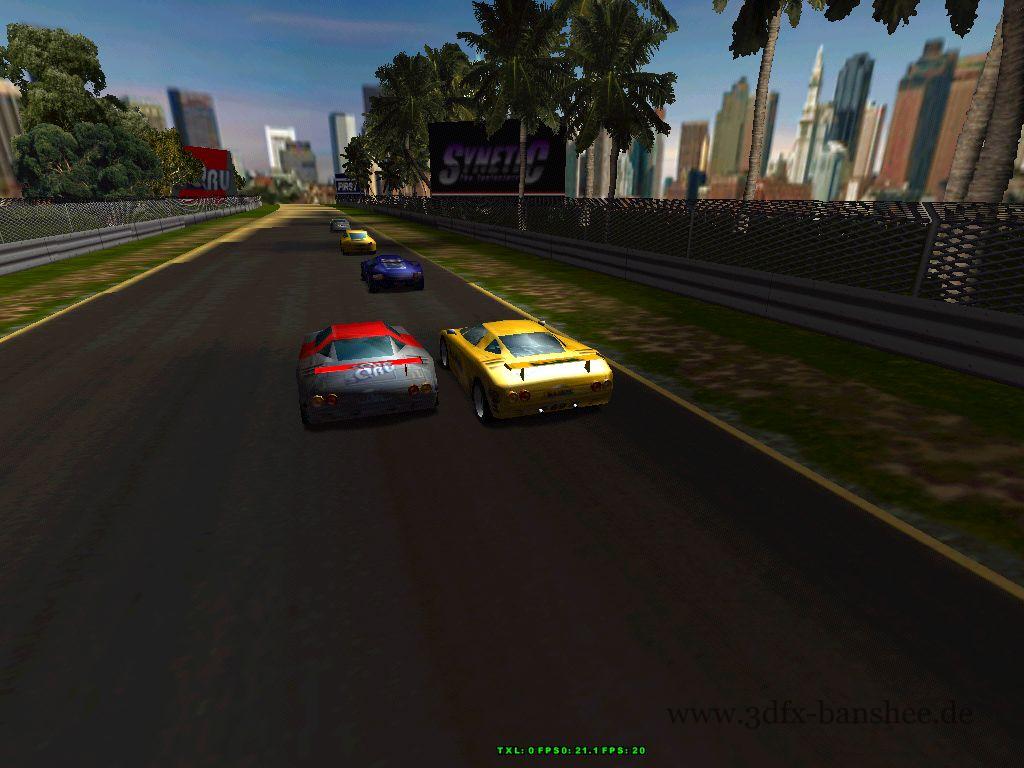
Savage 3D vs. N.I.C.E.2 - bad filtering on the track
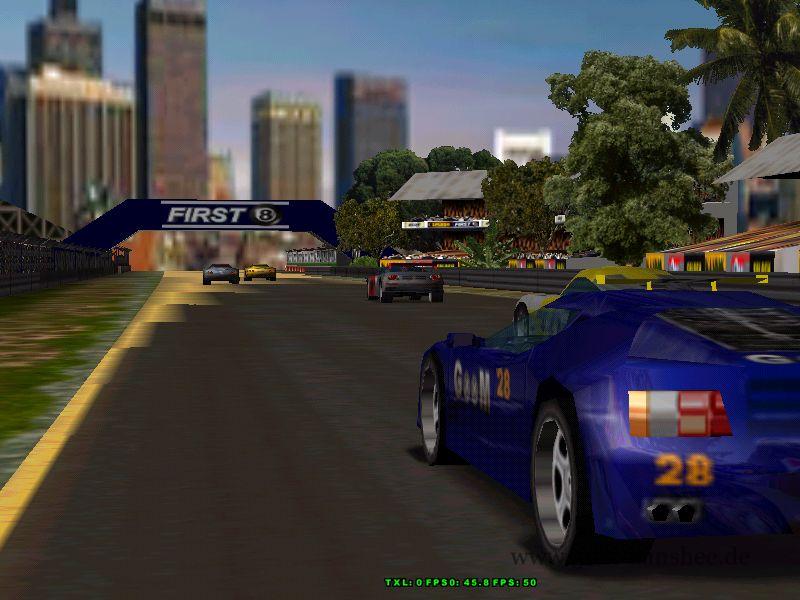
TNT with old driver - bad filtering on the track
Both Quake 2 and Turok 2 are rendered well by all cards, only the flickering issue found in Expendable also shows up in Turok 2 when the Savage 3D in combination with the older driver. Again, turning VSync on helps, but naturally affects performance.
Banshee and TNT are the only cards, that render the Unreal flyby scene completely correct with both drivers. The Savage 3D shows minor graphical glitches with both drivers where some objects flicker/disappear or the like, which is does not affect the visual impression too much. The older driver also seems to have some problems with the lighting and renders the scene a bit dark.
The Matrox G200 shows several issues with the v4.50 driver that are mostly gone with the new driver. The whole scene is pretty dark, especially the shadows behind the castle.
Also the fog is very dark and partly black when flying under the bridge. The sky is unfitered and blocky, so is the flag on the rear side of the castle. On the way to the castle are no reflections visible and the fire does not look very nice compared to the other cards.
The latter issues persist with the new driver.

G200 vs. Unreal - several shortcomings
Conclusion / Final Thoughts
If I am completely honest - the results surprised me. I was pretty sure that the TNT would come out on top in the end or at least in front of the Asus V3200, but this is not the case. But why is that?
Well, most of the comparison benches from way back in 1998 are done on preview boards, before the launch of TNT, Banshee and also the Savage 3D. The TNT (p)review Boards were clocked higher (95/113,5 vs. 90/110) and I THINK nVidia optimized their early drivers heavily on the Quake 2 engine (although I have no proof for that). THG even had a Savage 3D preview board back then for the comparison, which clocked way higher (125 MHz vs. 100 MHz of regular release cards).
So - the tested cards did not always match the final specs and the drivers were very early or pre-release state.
Also, most reviews back the mainly consisted of several Quake 2 timedemos or Q2 Engine games like SiN, where the TNT could shine with its Single-Pass-Multitexturing and Banshee had its problems. With that being said, let's have a look on all tested cards in order of their release.
The Matrox G200 was the company's first chip usable for 3D gaming. It offered very good 3D image quality and also top notch 2D capabilities. The fact that it overclocks so well also shows the build quality of the hardware. Its biggest problem were the rather slow drivers in 1998 and the lack of an OpenGL ICD troughout almost its whole "lifetime".
With later drivers, performance was improved drastically, but with newer games released, its small 8MB framebuffer became the bottleneck. A revised card with higher clockspeeds and more memory as well as a full OpenGL ICD released until late 1998 could have helped Matrox to stay more relevant among gamers. Maybe then its excellent successor, the G400, would have also been more successful.
The Savage 3D was a chip with huge potential on paper. The higher clocked preview boards promised performance on the level of TNT and Banshee in some areas and the finer production process comared to all other competitors should have allowed S3 to achieve these speeds on the production boards. Unfortunately that didn't happen and also the drivers showed several problems even in popular games and the performance was disappointing overall. Even with the final driver version, the Savage 3D virtually shows no performance improvement.
nVidias TNT was a vast improvement over the company's previous card, the Riva128. This is especially true for 3D image quality, but also for the quality of the drivers.
Initially, nVidia announced the card with much higher clockspeeds of 125 Mhz that just couldn't be delivered. The final clocks of only 90 MHz were a major disappointment but still - the TNT was a fantastic product overall. As it turned out, the rather slow clockspeed was not even the biggest problem, which can be seen in the benchmarks. The TNT @ 110 MHz core does not scale very well, most of the time it is limited by the memory transfer rate. Faster memory clocks really could have helped in regards of performance, but instead overclocking the memory on a TNT is next to impossible. On my card I could not overclock at all because at least N.I.C.E.2 had showed problems with even the slightest overclock. Reviewers from back in the day also reported very poor memory OC capabilities on TNT cards.
The last card to the market out of the round-up was the 3dfx Banshee. Pre-release benchmarks suggested lower performance than its main rival from nVidia. As shown in these benchmarks this is not true most of the time. The Banshee wins almost every benchmark and this is true for both driver sets. Also even with the early drivers there were very little driver-related problems. Turok 2 wouldn't let us use Glide with the 1998 driver, but D3D performance was still top notch. Also Quake 2 did not want to run in resolutions above 800x600 with the 1998 driver, but this was apperently not a problem with Quake 2 with earlier patchlevels, as older benchmarks of the Banshee show results in the 1024x768 resolution.
So what's left to resume is, that the 3dfx Banshee was overall the best 2D/3D solution in 1998. It had excellent game compatibility including Glide support, which was still a big deal back in 1998. Furthermore, its optional "22 Bit Postfilter" enabled it to enhance the visuals of many games at a rather low impact on performance as opposed to the 32Bit rendering option of the TNT which was next to unusable in performance regards.
The TNT was featurewise the more futureproof card with its support for larger textures, true AGP support and 32 Bit rendering but its performance was still too low to make use of most of the eyecandy features. The Banshee on the other hand was optimized for speed and featured all 3D capabilities of the extremely succesful Voodoo 2 3D core minus the Single-Pass-Multitexturing support. Its biggest problem was the marketing disadvantage over the TNT because of missing new features and the performance disadvantage in many games compared to its predecessor, the Voodoo 2 (SLI).
I hope you enjoyed this article as much as I enjoyed creating it - thank you for reading!

very giod in depth look.. greatt job
nice reviews ,only i wonder how the benchmarks run with the last windows 98 driver version1.04.00 and more games like shogo and revolt and maybe even the windows xp drivers.
Well, generally newer drivers are always better. Perhaps I’ll do a comparison of various driver versions in some games but actually this doesn’t make too much sense. Just take the latest driver and all is good. But Windows XP is definitely the wrong OS for a Banshee. Windows 98SE works best by far.
Hello,
Great article! I really enjoyed reading it. My Retro gig that I use daily is an:
Intel SE440BX PIII “Katmai” 450Mhz
BIOS Rev. 4S4EB0X1.86A.0032.P12
256MB, 75GBHD, 3.5FD, Voodoo Banshee 16MB
SB Live, CT7160 MPEG-2 PCI Decoder
3Com 3C905B-TX PCI NIC, Iomega Zip 100
Creative 5x PC-DVD, Sony 52x32x52x CDRW
Win 98SE
I love it and use it daily! I was never able to afford such a Rig back in the day, so now I’m able to relive those days with the type of Rig I wanted back then, especially my Banshee! I’m planning on getting another Banshee to keep as an extra. Ideally I would like to get one that is of a different brand/manufacturer.
Best wishes,
Tony.
Hi Tony, thanks for your comment, I’m glad you like it 🙂
Cool machine with lots of nice parts you have there! Highlight for me are the MPEG2 card and the DVD drive. I also have that card in a K6 (1st Gen) 300Mhz Machine, where it really makes a difference. The K6 is absolutely incapable of processing DVD material and the card makes the playback super smooth. Did you also try DVD playback with and without it? I frankly can’t remember which kind of CPU was needed to watch DVDs without such a card. Sadly I don’t have the original Creative drive that you have, that’s really cool!
My system is based on an Asus P2B , BX slot 1 MB. I currently have my Ensonic Banshee, with the vanguard memory, running @ 100/110. That’s on the Creative Banshee drivers that recognize the card. The soundcard is a Creative Ensonic Audio PCI. Running two hard drives a 6 gig and a 40 gig and 128 megs of ram. For cpu’s i have a few choices. I have a slot 0ne P3 400mhz that is in it now. It is a nice balance for the banshee. Optionally I have two other cpu s the one I had in the system in 99, a celeron 300a , that clocks to 450 in a microstar, MS-6905 slocket converter. I also have a celeron 700 that overclocks to 1 gig in the same converter. The fan is a Golden Orb.
Ah, Intel BX platform, classic 🙂 Also a very good motherboard you have there.
400 MHz is certainly enough for a banshee, so no need for a faster CPU. I would personally go for the OC’ed Celeron, which has some more “flair” than a small PIII (btw. a 400 MHz PIII does not exist, I assume you have a PII Deschutes there?).
My alternate choices (for my machine) would be Socket 7 with a K6-2+ or K6-III+, or a 300 MHz PII with Klamath core. The Klamath would probably be a limiting factor depending on which game is played, but I like the CPU. So far, I am happy with my Celeron setup but I might change it to something else in the future.
darn spell check the second card is an Esonic
Great review, and yes I did enjoy it. As you pointed out the Banshee was a top performer in 99. I still have my retro rig from 99 running as well! I have two Banshee cards a Creative labs one with the original box, CD and receipt, and an Iconic one I picked up used a few years ago. I run them both on Creative drivers.
Thank you for your feedback, I am really happy you enjoyed it 🙂 What does the rest of your `99 system look like? My current Banshee system is backed by a S370 Celeron Mendocino, which fits great. But I had several other options in mind – I’m curious to read what you ended up with 😉